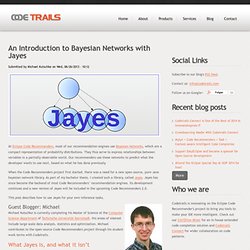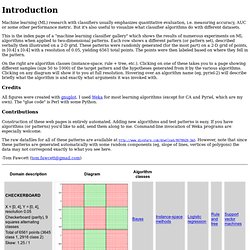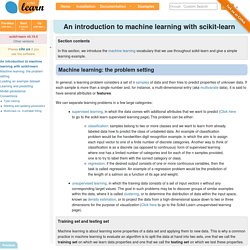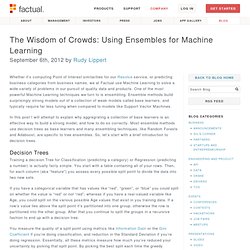

Blogs about machine learning, statistics, recommendations, and related topics. Blogs about machine learning, statistics, recommendations, and related topics. Trends in Machine Learning. An Introduction to Bayesian Networks with Jayes. At Eclipse Code Recommenders, most of our recommendation engines use Bayesian Networks, which are a compact representation of probability distributions.

They thus serve to express relationships between variables in a partially observable world. Our recommenders use these networks to predict what the developer wants to use next, based on what he has done previously. When the Code Recommenders project first started, there was a need for a new open-source, pure-Java bayesian network library. As part of my bachelor thesis, I created such a library, called Jayes. Jayes has since become the backend of most Code Recommenders’ recommendation engines. This post describes how to use Jayes for your own inference tasks. Guest Blogger: Michael Michael Kutschke is currently completing his Master of Science at the Computer Science department of Technische Universität Darmstadt.
What Jayes is, and what it isn’t Jayes is a library for Bayesian networks and the inference in such networks. How do I use it? The Machine Learning Dictionary. Machine learning classifier gallery. Machine learning (ML) research with classifiers usually emphasizes quantitative evaluation, i.e. measuring accuracy, AUC or some other performance metric.

But it's also useful to visualize what classifier algorithms do with different datasets. This is the index page of a "machine learning classifier gallery" which shows the results of numerous experiments on ML algorithms when applied to two-dimensional patterns. Each row shows a different pattern (or pattern set), described verbally then illustrated on a 2-D grid. These patterns were randomly generated (for the most part) on a 2-D grid of points, in [0:4] x [0:4] with a resolution of 0.05, yielding 6561 total points. The points were then labeled based on where they fell in the pattern. On the right are algorithm classes (instance-space, rule + tree, etc.). Credits All figures were created with gnuplot. The Large Scale Learning class notes.
Courses:bigdata:slides:start. 1. An introduction to machine learning with scikit-learn — scikit-learn 0.13.1 documentation. Section contents.

The Wisdom of Crowds: Using Ensembles for Machine Learning - Factual Blog. Whether it’s computing Point of Interest similarities for our Resolve service, or predicting business categories from business names, we at Factual use Machine Learning to solve a wide variety of problems in our pursuit of quality data and products.

One of the most powerful Machine Learning techniques we turn to is ensembling. Ensemble methods build surprisingly strong models out of a collection of weak models called base learners, and typically require far less tuning when compared to models like Support Vector Machines. In this post I will attempt to explain why aggregrating a collection of base learners is an effective way to build a strong model, and how to do so correctly. Most ensemble methods use decision trees as base learners and many ensembling techniques, like Random Forests and Adaboost, are specific to tree ensembles. So, let’s start with a brief introduction to decision trees. Decision Trees Finally, the leaf nodes of the tree represent predictions. Random Forests.
Us : Distributed Online Machine Learning Framework — Jubatus. Introduction to Machine Learning. Practical information Lectures: Monday and Wednesday, 12:00PM to 1:20PMLocation: Baker Hall A51Recitations: Tuesdays 5:00PM to 6:00PMLocation: Porter Hall 100 (January 22, 2013), Doherty Hall A302 (January 29, 2013 onwards)Instructor: Barnabas Poczos (office hours 10am-12pm Thursdays in Gates 8231) and Alex Smola (office hours 2-4pm Tuesdays in Gates 8002)TAs: Ina Fiterau (office hours 2-4pm Mondays in Gates 8021), Mu Li (office hours 5-6pm Fridays in Gates 7713), Junier Oliva (office hours 4:30-5:30pm Thursdays in Gates 8227), Xuezhi Wang (office hours 5-6pm Wednesdays in Gates 6503), Leila Wehbe (office hours 10:30-11:30am Wednesdays in Gates 8021)Grading Policy: Homework (33%), Midterm (33%), Project (33%), Final (34%) with best 3 out of 4 used for score (final is mandatory).Google Group: Join it here.
This is the place for discussions and announcements. Updates Overview Resources For specific videos of the class go to the individual lectures. Prerequisites Schedule. David W. Aha: Machine Learning Page. Apache Mahout: Scalable machine learning and data mining. Learning From Data - Online Course. A real Caltech course, not a watered-down version on YouTube & iTunes Free, introductory Machine Learning online course (MOOC) Taught by Caltech Professor Yaser Abu-Mostafa [article]Lectures recorded from a live broadcast, including Q&APrerequisites: Basic probability, matrices, and calculus8 homework sets and a final examDiscussion forum for participantsTopic-by-topic video library for easy review Outline This is an introductory course in machine learning (ML) that covers the basic theory, algorithms, and applications.

ML is a key technology in Big Data, and in many financial, medical, commercial, and scientific applications. Prismatic Architecture - Using Machine Learning on Social Networks to Figure Out What You Should Read on the Web. This post on Prismatic’s Architecture is adapted from an email conversation with Prismatic programmer Jason Wolfe.

What should you read on the web today? Any thoroughly modern person must solve this dilemma every day, usually using some occult process to divine what’s important in their many feeds: Twitter, RSS, Facebook, Pinterest, G+, email, Techmeme, and an uncountable numbers of other information sources. Jason Wolfe from Prismatic has generously agreed to describe their thoroughly modern solution for answering the “what to read question” using lots of sexy words like Machine Learning, Social Graphs, BigData, functional programming, and in-memory real-time feed processing. The result is possibly even more occult, but this or something very much like it will be how we meet the challenge of finding interesting topics and stories hidden inside infinitely deep pools of information.
A couple of things stand out about Prismatic. Stats Platform Data Storage and IO Services. Introduction to Machine Learning. Practical information Lectures: Monday and Wednesday, 12:00PM to 1:20PMLocation: Baker Hall A51Recitations: Tuesdays 5:00PM to 6:00PMLocation: Porter Hall 100 (January 22, 2013), Doherty Hall A302 (January 29, 2013 onwards)Instructor: Barnabas Poczos (office hours 10am-12pm Thursdays in Gates 8231) and Alex Smola (office hours 2-4pm Tuesdays in Gates 8002)TAs: Ina Fiterau (office hours 2-4pm Mondays in Gates 8021), Mu Li (office hours 5-6pm Fridays in Gates 7713), Junier Oliva (office hours 4:30-5:30pm Thursdays in Gates 8227), Xuezhi Wang (office hours 5-6pm Wednesdays in Gates 6503), Leila Wehbe (office hours 10:30-11:30am Wednesdays in Gates 8021)Grading Policy: Homework (33%), Midterm (33%), Project (33%), Final (34%) with best 3 out of 4 used for score (final is mandatory).Google Group: Join it here.

This is the place for discussions and announcements. Updates Overview Resources. MLcomp - Home. Deep Learning for NLP (without Magic) - Part 1. Deep Learning Tutorial - www.socher.org. Slides Updated Version of Tutorial at NAACL 2013 See Videos High quality video of the 2013 NAACL tutorial version are up here: quality version of the 2012 ACL version: on youtube Abstract Machine learning is everywhere in today's NLP, but by and large machine learning amounts to numerical optimization of weights for human designed representations and features.

Outline References All references we referred to in one pdf file Further Information A very useful assignment for getting started with deep learning in NLP is to implement a simple window-based NER tagger in this exercise we designed for the Stanford NLP class 224N. For your comments, related questions or errata: Save your text first, then fill out captcha, then save again. Wenbo? Hi Richard, I am a big fan of your C S224d? Gebre? 2nd Lisbon Machine Learning School (2012) Machine Learning Summer School (MLSS), La Palma 2012 - VideoLectures. (143) Large Scale Learning: What are some introductory resources for learning about large scale machine learning? Why? CS 229: Machine Learning Final Projects, Autumn 2012.